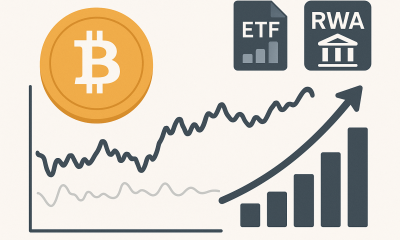

Metaverse
Many AI researchers think fakes will become undetectable – Crypto News
The video is fake. Generated with the help of AI, it is just one of 143 such advertisements catalogued by Fenimore Harper Communications, a British firm, which ran in December and January. It is not just those in the public eye who can have their likenesses used for dubious ends. In June 2023 the Federal Bureau of Investigation in America warned the public of “malicious actors” using AI to create fake sexually themed videos and images of ordinary people, in order to extort money.
How to detect such trickery is a live topic among AI researchers, many of whom attended NeurIPS, one of the field’s biggest conferences, held in New Orleans in December. A slew of firms, from startups to established tech giants such as Intel and Microsoft, offer software that aims to spot machine-generated media. The makers of big AI models, meanwhile, are searching for ways of “watermarking” their output so that real pictures, video or text can be readily distinguished from the machine-generated sort.
But such technologies have not, so far, proved reliable. The AI cognoscenti seem gloomy about their prospects. The Economist conducted a (deeply unscientific) straw poll of delegates to NeurIPS. Of 23 people asked, 17 thought AI-generated media would eventually become undetectable. Only one believed that reliable detection would be possible. (The other five demurred, preferring to wait and see.)
Detection software relies on the idea that AI models will leave a trace. Either they will fail to reproduce some aspect of real images and video, or of human-generated text, or they will add something superfluous—and will do so often enough to let other software spot the error. For a while, humans could do the job. Up until about the middle of 2023, for instance, image-generation algorithms would often produce people with malformed hands, or get the numbers wrong on things like clock faces. These days, the best no longer do.
But such telltales often still exist, even if they are becoming harder for humans to spot. Just as machines can be trained to reliably identify cats, or cancerous tumours on medical scans, they can also be trained to differentiate between real images and AI-generated ones.
It seems, though, that they cannot do so all that well. Detection software is prone to both false positives (wrongly flagging human content as generated by AI) and false negatives (allowing machine-generated stuff to pass undetected). A pre-print published in September by Zeyu Lu, a computer scientist at Shanghai Jiao Tong University, found that the best-performing program failed to correctly spot computer-generated images 13% of the time (though that was better than the humans, who erred in 39% of cases). Things are little better when it comes to text. One analysis, published in December in the International Journal of Educational Integrity, compared 14 tools and found that none achieved an accuracy of more than 80%.
If trying to spot computer-generated media after the fact is too tricky, another option is to label it in advance with a digital watermark. As with the paper sort, the idea is to add a distinguishing feature that is subtle enough not to compromise the quality of the text or image, but that is obvious to anyone who goes looking for it.
One technique for marking text was proposed by a team at the University of Maryland in July 2023, and added to by a team at University of California, Santa Barbara, who presented their tweaks at NeurIPS. The idea is to fiddle with a language model’s word preferences. First, the model randomly assigns a clutch of words it knows to a “green” group, and puts all the others in a “red” group. Then, when generating a given block of text, the algorithm loads the dice, raising the probability that it will plump for a green word instead of one of its red synonyms. Checking for watermarking involves comparing the proportion of green to red words—though since the technique is statistical, it is most reliable for longer chunks of writing.
Many methods for watermarking images, meanwhile, involve tweaking the pixels in subtle ways, such as shifting their colours. The alterations are too subtle for human observers to notice, but can be picked up by computers. But cropping an image, rotating it, or even blurring and then resharpening it can remove such marks.
Another group of researchers at NeurIPS presented a scheme called “Tree-Ring” watermarking that is designed to be more robust. Diffusion models, the most advanced type of image-generation software, begin by filling their digital canvas with random noise, out of which the required picture slowly emerges. The tree-ring method embeds the watermark not in the finished picture, but in the noise at the start. If the software that created a picture is run in reverse, it will reproduce the watermark along with the noise. Crucially, the technique is less easy to thwart by fiddling with the final image.
But it is probably not impossible. Watermarkers are in an arms race with other researchers aiming to defeat their techniques. Another team led by Hanlin Zhang, Benjamin Edelman and Boaz Barak, all of Harvard University, presented a method (not yet peer-reviewed) that can, they say, erase watermarks. It works by adding a dash of new noise, then using a second, different AI model to remove that noise, which removes the original watermark in the process. They claim to be able to foil three new text-watermarking schemes proposed in 2023. In September scientists at the University of Maryland published a paper (also not yet peer-reviewed) claiming that none of the current methods of image watermarking—Tree-Rings included—is foolproof.
Nevertheless, in July 2023 America’s government announced “voluntary commitments” with several AI firms, including OpenAI and Google, to boost investment in watermarking research. Having imperfect safeguards is certainly better than having none (although open-source models, which users are free to tweak, will be harder to police.) But in the battle between the fakers and the detectives, it seems that the fakers have the upper hand.
© 2023, The Economist Newspaper Limited. All rights reserved.
From The Economist, published under licence. The original content can be found on www.economist.com
-

 Cryptocurrency1 week ago
Cryptocurrency1 week agoIlluminating progress: Is a $140K income ‘poor’? – Crypto News
-

 Technology1 week ago
Technology1 week agoSamsung Galaxy S25 Ultra 5G for under ₹80,000 on Flipkart? Here’s how the deal works – Crypto News
-
Technology1 week ago
Crypto Lawyer Bill Morgan Praises Ripple’s Multi-Chain Strategy as RLUSD Hits $1.1B – Crypto News
-

 Blockchain6 days ago
Blockchain6 days agoAnalyst Reveals What You Should Look Out For – Crypto News
-

 others1 week ago
others1 week agoGold holds strong at $4,200 as Fed-cut anticipation builds – Crypto News
-
others6 days ago
Breaking: Labor Department Cancels October PPI Inflation Report Ahead of FOMC Meeting – Crypto News
-

 Cryptocurrency6 days ago
Cryptocurrency6 days agoArgentina moves to reshape crypto rules as banks prepare for Bitcoin services – Crypto News
-

 Blockchain5 days ago
Blockchain5 days agoStripe and Paradigm Open Tempo Blockchain Project to Public – Crypto News
-
others1 week ago
Bitcoin Price Forecast as BlackRock Sends $125M in BTC to Coinbase — Is a Crash Inevitable? – Crypto News
-

 Technology1 week ago
Technology1 week agoWorking on a screen all day? These 8 LED monitors in Dec 2025 are kinder on your eyes – Crypto News
-

 Cryptocurrency1 week ago
Cryptocurrency1 week agoFlorida Appeals Court Revives $80M Bitcoin Theft – Crypto News
-

 Cryptocurrency1 week ago
Cryptocurrency1 week agoCrypto Holiday Gift Guide 2025 – Crypto News
-

 Blockchain5 days ago
Blockchain5 days agoBMW Helps JPMorgan Drive Blockchain-Based FX Payments – Crypto News
-
others1 week ago
XRP Price Prediction As Spot ETF Inflows Near $1 Billion: What’s Next? – Crypto News
-

 others1 week ago
others1 week agoThe rally to 7120 continues – Crypto News
-
others1 week ago
Morgan Stanley Turns Bullish, Says Fed Will Cut Rates by 25bps This Month – Crypto News
-

 Blockchain1 week ago
Blockchain1 week agoBitcoin Buries The Tulip Myth After 17 Years: Balchunas – Crypto News
-

 Cryptocurrency1 week ago
Cryptocurrency1 week agoCoinDCX data reveals India’s rising appetite for diversified digital assets – Crypto News
-

 Technology1 week ago
Technology1 week agoCloudflare Resolved Services Issues Caused by Software Update – Crypto News
-
Technology1 week ago
Solana Price Outlook: Reversal at Key Support Could Lead to $150 Target – Crypto News
-

 others1 week ago
others1 week agoCanadian Dollar soars after upbeat labor report – Crypto News
-

 Cryptocurrency1 week ago
Cryptocurrency1 week agoWhy Ethereum strengthens despite whale selling – Inside Asia premium twist – Crypto News
-

 others1 week ago
others1 week agoNasdaq futures hold key structure as price compresses toward major resistance zones – Crypto News
-

 others1 week ago
others1 week agoNasdaq futures hold key structure as price compresses toward major resistance zones – Crypto News
-
Business1 week ago
Bitcoin, ETH, XRP, SOL’s Max Pain Price as Over $4B Options to Expire – Crypto News
-
Business1 week ago
Is ZCash Price Set for a Bigger Rally After Its 10% Surge on the Bitget Listing? – Crypto News
-
others1 week ago
Colombia Consumer Price Index (YoY) below forecasts (5.45%) in November: Actual (5.3%) – Crypto News
-
Technology1 week ago
Bitcoin Stalls Ahead of FOMC as Analyst Van de Poppe Sees No Break Until Tuesday – Crypto News
-

 Technology1 week ago
Technology1 week agoFrom security camera to gaming hub: 6 Easy tricks to make your old smartphone genuinely useful again – Crypto News
-

 Cryptocurrency1 week ago
Cryptocurrency1 week agoGlassnode report reveals Bitcoin’s growing stability amid ETF activity and RWA expansion – Crypto News
-
others1 week ago
$1.3T BPCE To Roll Out Bitcoin, Ethereum and Solana Trading For Clients – Crypto News
-

 others1 week ago
others1 week agoStocks survive PCE and consumer data – FOMC too? – Crypto News
-

 Cryptocurrency1 week ago
Cryptocurrency1 week agoThursday links: Prediction markets, agent hackers, quantum risks – Crypto News
-

 Technology7 days ago
Technology7 days agoStarlink India pricing revealed: How much does monthly plan cost and what are its benefits? – Crypto News
-
others5 days ago
Bitcoin, Ethereum, XRP, Solana Rally Ahead of Fed Rate-Cut Decision – Crypto News
-

 Metaverse1 week ago
Metaverse1 week agoGoogle’s new AI tech unmasks fake images. – Crypto News
-

 Cryptocurrency1 week ago
Cryptocurrency1 week agoBitcoin whales freeze – Is BTC drifting toward $86.5K danger zone? – Crypto News
-
Business1 week ago
HashStaking Review: The Smarter Way to Grow Your Crypto in 2025 – Crypto News
-
Technology1 week ago
Peter Brandt Hints at Further Downside for Bitcoin After Brief Rebound – Crypto News
-
Business1 week ago
Why is the LUNC Price Up 70% Despite the Crypto Market’s Decline? – Crypto News
-
others1 week ago
United States Consumer Credit Change came in at $9.18B, below expectations ($10.5B) in October – Crypto News
-

 Technology1 week ago
Technology1 week agoSamsung’s Galaxy S26 range leaks with circular cameras and Android 16 upgrade: What to expect – Crypto News
-

 others1 week ago
others1 week agoAussie eyes YTD high after channel breakout – Crypto News
-

 Technology1 week ago
Technology1 week agoTier 2 and Tier 3 cities drive over 90% of engagement on audio social platforms in India, says report – Crypto News
-

 Blockchain1 week ago
Blockchain1 week agoBittensor Set for First TAO Halving on Dec. 14 – Crypto News
-

 others1 week ago
others1 week agoNasdaq futures hold key structure as price compresses toward major resistance zones – Crypto News
-

 Blockchain7 days ago
Blockchain7 days agoSolana (SOL) Recovery Momentum Hinges on Price Closing Firmly Above $140 – Crypto News
-

 Blockchain7 days ago
Blockchain7 days agoBitcoin Santa Rally Talk Meets Last FOMC of 2025 – Crypto News
-

 Blockchain7 days ago
Blockchain7 days agoEthereum Founder Breaks Silence With Major Upgrade Proposal – Crypto News
-
Business6 days ago
Solana Price Set for $150+ as Bullish Sentiment Rises in Crypto Market – Crypto News














